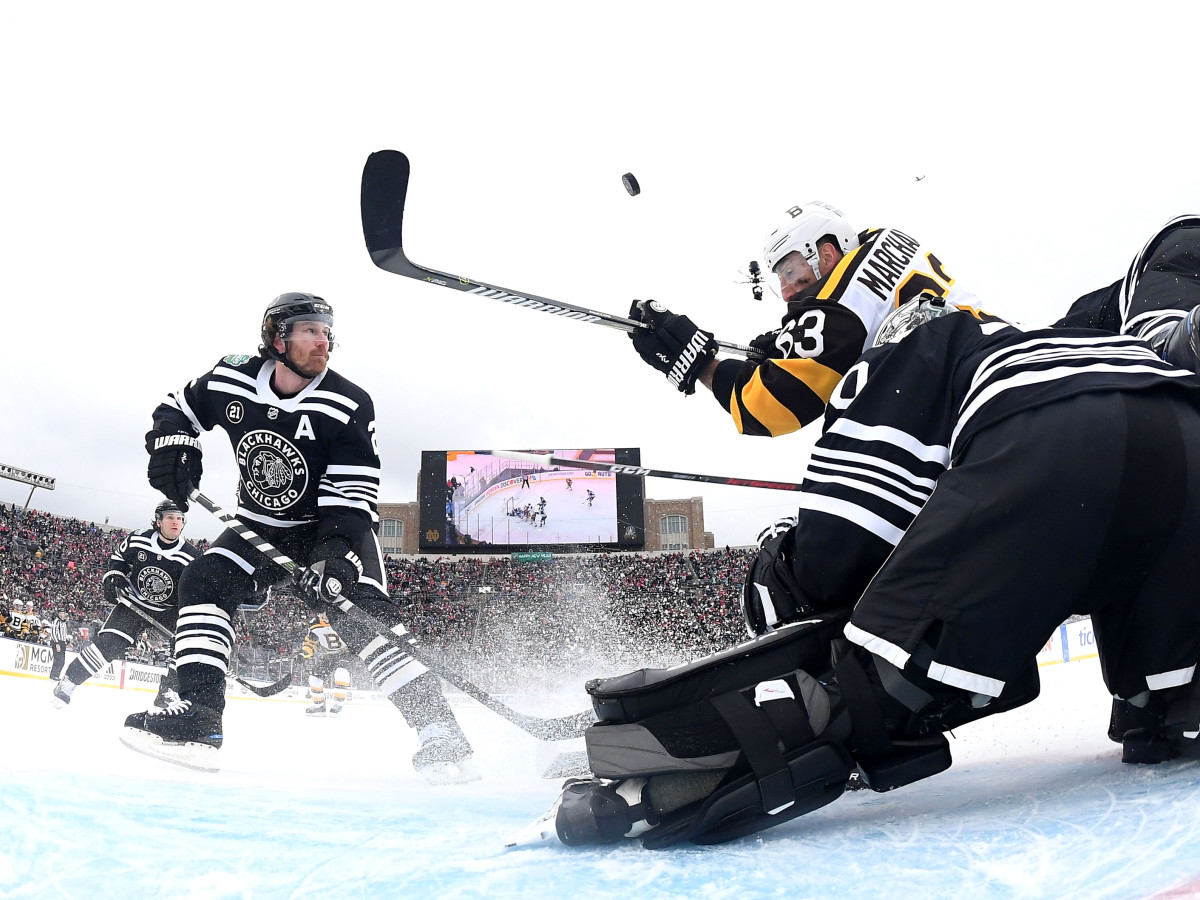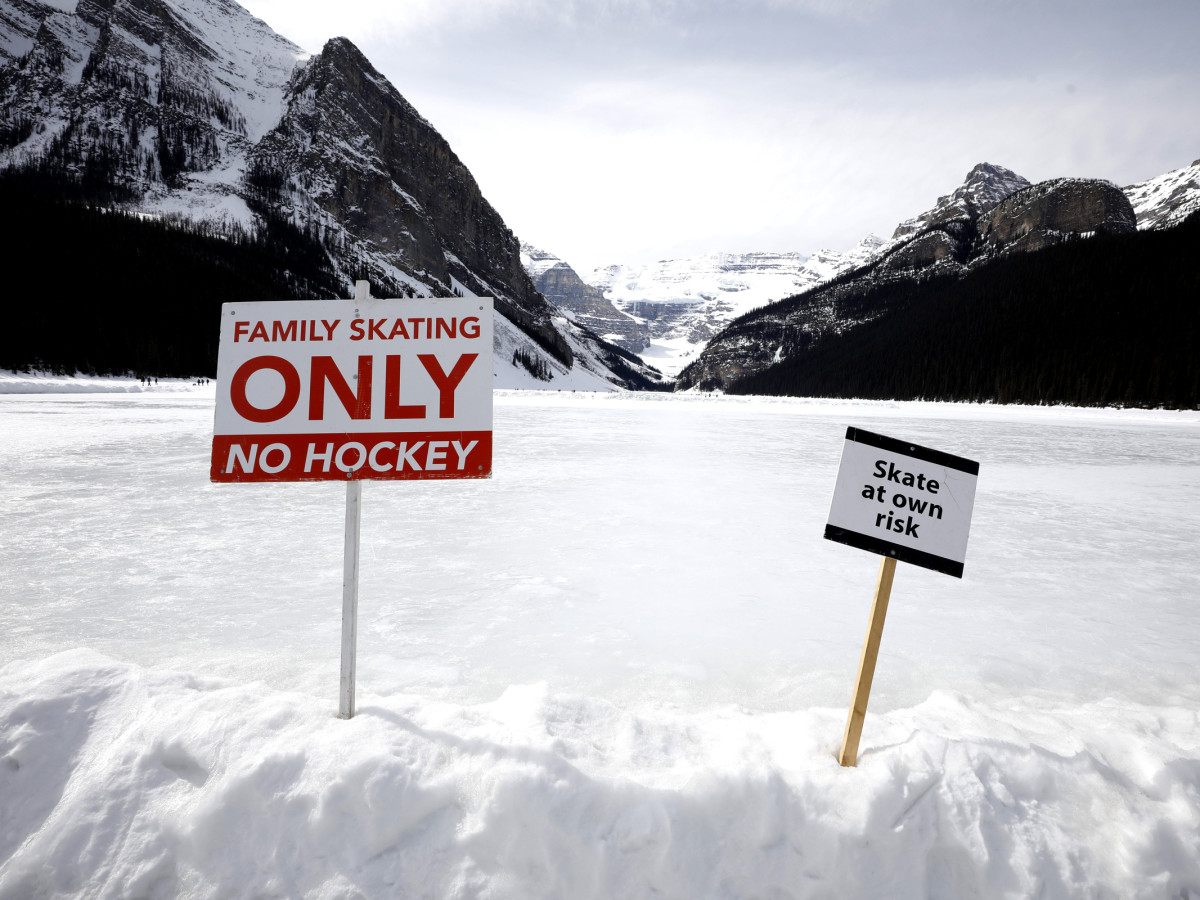Winter Is Going: How Climate Change Is Imperiling Outdoor Sporting Heritage

This story appears in the April 22, 2019, issue of Sports Illustrated. For more great storytelling and in-depth analysis, subscribe to the magazine—and get up to 94% off the cover price. Click here for more.
The most famous backyard in Canada is on a quiet street in the north end of Brantford, Ont. It was here, behind the modest gable-roofed home at 42 Varadi Avenue, that the boy who would become the Great One spent winters skating outside on an ice rink built by his father, developing the inimitable creativity that would define his game.
For hours in the cold, a young Wayne Gretzky would toil on that patch of ice frozen over grass known as "Wally's Coliseum," named for Wayne's father, Walter. (Before the Gretzkys moved in, Walter inspected the backyard to make sure it was spacious and flat enough for a rink.) Often Wayne practiced alone. Pretending he was Gordie Howe, he would skate around tin cans, fake passes and fire shots, taking aim at a turned-over picnic table.
Though Walter's backyard rink has since been replaced by an in-ground pool, the home remains sacred for Gretzky devotees, hockey's own Church of the Nativity. Once, Walter watched through the window as a woman tore a chunk of grass from the front lawn, dashed back to her car and sped off. It's one reason Brantfordians venerate outdoor skating, either in their own backyards or on community park rinks.
It's not just Brantford, though, and it's not just the Gretzkys. All across Canada and the northern U.S., outdoor hockey—played on frozen ponds, backyard ice and community rinks—has long enlivened dreary winters. In future stars (and mere beer-league hobbyists) it nurtures adaptiveness and flair. A line from Roch Carrier's children's book, The Hockey Sweater, once graced the back of Canada's five-dollar bill: "The winters of my childhood were long, long seasons. We lived in three places—the school, the church and the skating rink—but our life was on the skating rink." Bobby Orr once called backyard rinks "the heart and soul of hockey."
In recent years, the NHL has turned the sport's outdoor roots into a nostalgia-soaked—and wildly successful—marketing tool by way of the Winter Classic and Stadium Series. Many of the players starring in this spring's playoffs grew up playing outdoors, where the game is at its most accessible. The origins of ice hockey are murky—several Canadian towns claim to be the modern game's birthplace—but the "great northern sport," as SI once called it, was played outdoors for years, possibly decades, before the first indoor game was played on March 3, 1875, in Montreal.
That heritage is now threatened by rising global temperatures. Since 1950, Ontario has warmed by 1.4° Celsius, or 2.5° Fahrenheit, according to the Ontario Centre for Climate Impacts and Adaptation Resources. That number could increase to between 2.5° and 3.7° Celsius by 2050. While the globe as a whole has warmed an average of 1° Celsius since the start of the Industrial Revolution in the 19th century, the Northern Hemisphere's winters, in particular, are warming rapidly: In the United States, average winter temperatures in every state have warmed at least 1° Fahrenheit since 1970, and in four hockey-mad states—Alaska, Minnesota, Vermont and Wisconsin—winters have warmed by more than 5°.
As average temperatures continue to rise, the number of days suitable for skating will fall. Lori-Dawn Cavin, who manages Brantford's 27 community rinks, considers 40 skating days a good winter. Since 2005, when the parks and recreation department started keeping records, the number of skating days has fluctuated wildly each year. In the winter of '13–14, for instance, the city's rinks combined for 1,017 skating days, or an average of 51 per rink. But in '11–12, the parks managed only 17 combined skating days. In the season that just concluded, the Brantford rinks combined for 351 skating days; only two had 40.
But the evidence isn't just anecdotal. Data collected by RinkWatch, a citizen science project cofounded by Robert McLeman, an environmental scientist at Wilfrid Laurier University in Ontario, indicates that the number of high-quality skateable days in Toronto has dropped precipitously in the last few decades. From the late 1950s to the early '80s, Toronto averaged between 35 and 42 of those days; recently, that number has fallen by 25% and projects to fall another 33% by the year 2090.
When we think about climate change, we think of catastrophe: flooded coastal cities, prolonged droughts, uncontrollable wildfires. But the changing climate is also affecting us in subtler ways, as with the challenge it poses to outdoor winter recreation. In places like Brantford, that means the erosion of a proud outdoor-rink culture. But it's also the snow-sports industry and ski towns, forced to adapt to less snowpack; the Iditarod, rerouting in search of snow; ice fishermen, kept off ponds by unsafe conditions.
Winter sports, unlike the glaciers of Glacier National Park or ash trees of the Northeast, aren't going away anytime soon. The NHL plays its games in climate-controlled arenas, and competitive skiing often relies on artificial snow. But as climate change forces communities like Brantford to consider forfeiting their beloved winter pastimes, we'll have to reckon with an existential question: What will we lose if we can't play sports where they're meant to be played?

Over the past two centuries, as humans have burned fossil fuels like coal, gas and oil—producing carbon emissions—atmospheric concentrations of carbon dioxide have skyrocketed to their highest level in more than 400,000 years, passing 400 parts per million in 2013. (A relatively safe level, scientists say, is 350 parts per million.) Because carbon dioxide is a heat-trapping gas, the planet has warmed rapidly over the last century, after thousands of years of relative stability. Twenty years ago scientists plotted those temperature changes on a graph and created one of the most famous charts in modern science: the hockey stick.
Climate modeling has come a long way since then, but the last few thousand years of temperatures indeed look a lot like a twig from Bauer or CCM: a horizontal line, albeit with a few small peaks and valleys, culminating in a sharp vertical spike. Globally, the last five years have been the hottest five on record, and the 20 hottest years on record have all occurred in the last 22 years.
With so much warming, and so much at stake, it's easy to shrug off global warming's effect on sports. It gets harder, though, when you see just how much has already been lost. The Elfstedentocht, a famed 200-kilometer speedskating race traditionally staged in the Dutch province of Friesland, hasn't been held in the Netherlands since 1997 for lack of suitable ice. Skaters, hoping to keep a winter tradition alive, moved an unofficial version of the event to higher ground in Austria. In 2018, the Montana Pond Hockey Classic, played on Foys Lake in Kalispell, was canceled because of unstable ice conditions for the second time in three years. In '17, the American Birkebeiner, the biggest cross-country ski race in North America, was nixed because of unseasonably warm weather and rain. In Alaska, the Iditarod has been forced to veer from its traditional route for lack of snow and stable ice.
According to one recent study, western U.S. states' snowpack—the lifeblood of winter mountain sports—has decreased by as much as 30% in the last century. Another study, completed before last year's PyeongChang Games, found that only eight of 21 previous Winter Olympic sites would be dependably cold enough to host the event by 2100, barring substantial reductions in greenhouse gas emissions.
A good skating day, experts say, is 22° Fahrenheit or colder but building an outdoor rink requires several days of sustained subfreezing temperatures, ideally hovering around 15° Fahrenheit. Rink-makers, who scrape and flood the ice each night to maintain a smooth, durable surface, perpetually eye the weather—one Canadian government meteorologist issues a rink-making forecast—because temperatures too close to the freezing point risk melting the ice; even on a cold day, the sun can turn ice to slush, especially if a rink overlays a dark surface like blacktop. To avoid starting from scratch after a winter thaw, some backyard rink-makers attach a large tarp or plastic liner to wooden boards, which causes the melted ice to pool rather than running off. On natural ice, of course, thaws are dangerous: To safely skate on a river or pond, the ice should be at least four inches thick; for snowmobiling, it should be five.
"It's become more and more stressful. Over these past half-dozen years, we're watching the weather so close leading up to the events," says Carson Kipfer, the co-commissioner of the U.S. Pond Hockey Championships in Minnesota. "It used to be you were kind of guaranteed these subfreezing temperatures."
Ski areas, in particular, are feeling the pinch of climate change. In New England, there are fewer days with snow on the ground and more winter rain events, making slopes unsuitable for skiing, while snowpack in California's Sierra Nevadas is declining significantly. Between 2001 and '16 the U.S. ski industry lost $1 billion and 17,400 jobs during low-snow seasons compared with an average year, according to a study conducted for Protect Our Winters, a climate advocacy coalition. As bad as the problem is in North America, it's even worse in Europe, where half of the Alps' glacial ice has already disappeared. The Swiss Alps' snow season is 37 days shorter than it was in 1970.
Ski resorts have invested in snowmaking and have expanded summer activities, such as mountain biking. But just as smaller municipalities—unlike, say, Toronto—can't afford to refrigerate their outdoor rinks, smaller ski hills are more financially vulnerable to unsuitable weather.
When McLeman, the RinkWatch cofounder, was young, he learned to ski at Chicopee, a small club in Kitchener, about 40 kilometers north of Brantford. Chicopee's modest slopes have introduced thousands of Ontarians, including Olympic skier Kelly VanderBeek, to skiing and snowboarding. "We're the feeder," says Bill Creighton, Chicopee's CEO. "That's where you grow a love for the sport. That's where you learn to do it."
On a bright day in early March, inside Chicopee's Silvertip Lounge, Creighton was meeting with Tova Davidson, the executive director of Sustainable Waterloo Region, a not-for-profit that advises local businesses on sustainability. Outside, seen through floor-to-ceiling windows, hundreds of children were skiing and snowboarding. Without snowmaking, Creighton acknowledged, Chicopee couldn't remain operational. "I believe my kids will ski here 20 years from now," he said. "Some other people might say, 'Hey, you should rethink that, Bill.'"
Davidson said, "They might be able to ski here because you've got technology that allows you to make snow. But this spot over here"—she gestured to a small wooded area at the bottom of a hill—"may well be green. And they may not walk out of their door and see snow."
The backyard effect, backed by scientific research, suggests that weather conditions in urban areas affect ski activity. For instance, if Boston is unseasonably warm, people are less likely to visit nearby ski resorts in New Hampshire, no matter their snowmaking capacity.
And man-made snow can be costly to manufacture and environmentally detrimental, though lately it has become more efficient. It involves feeding water—around 100 gallons a minute—and compressed air into snow guns, which blast out droplets that fall to the ground as snow crystals. But the result doesn't feel much like natural powder, which is much softer and slicker. "It's like the difference between a light generic beer and a really good bourbon," says Auden Schendler, a board member at Protect Our Winters and the vice president of sustainability at Aspen Skiing Company.
But with spring snow melting earlier and less snow on the ground than in the past, the ski industry is more reliant than ever on snow-making. Since the 1950s, more than 600 ski areas in New England alone have closed, according to the New England Lost Ski Areas Project. Most of those closures can't be attributed directly to climate change, but one 2014 study found that weather conditions have significant effects on the shuttering of ski areas.
"Were steroids the sole reason that Mark McGwire hit 70 home runs? Of course not—but it increased the odds," says Cameron Wake, a climate scientist and professor at the University of New Hampshire. "The same is true with closed ski areas."

When we lose something to environmental change, we feel a sense of distress known as solastalgia. The term, coined in 2003 by the philosopher Glenn Albrecht, could easily apply to Brantfordians unable to skate under slate-colored winter skies, or cross-country skiers unable to glide along any old chosen-at-random trail.
In Canada, where winter recreation is sacrosanct, that void would create a national identity crisis. "It speaks to the Canadian culture and ethos as an outdoor culture—we are out skiing and skating and tobogganing and sledding and all of those things," says Davidson, the director of the sustainability nonprofit. "And we actually are seeing a shift in the reality of who we are as a nation, because the climate is changing."
We can say with certainty that humans are warming the planet. What's less certain is how the planet will respond—in other words, the climate's sensitivity to human-induced change—and, more importantly, how we respond. Global warming's dangers have been apparent for decades, but the situation has become dire and is growing more dire every day. In hockey parlance, it's long past time to pull the goalie.
"You hear about climate change and it's almost overwhelming," Kevin Davis, Brantford's mayor, says. "As one person, or one city, what can we do? And the reality is we can do our little bit, and we are going to, but probably the overall impact of that is negligible." The NHL and ski resorts, likewise, are eager to reduce their carbon footprints—and the league has even launched an initiative to encourage all indoor rinks throughout North America to improve their ice-making processes, upgrade their refrigeration equipment and cut their emissions. But global warming would continue unabated even if entire sports leagues and industries zeroed out their emissions; the broader change required to recool northern winters would have to come from sweeping, coordinated action.
There isn't much cause for environmental optimism these days. But it's hard not to feel a glimmer of hope when Brantford's volunteer rink-makers labor for hours every night in the cold, tenderly caring for their ice, motivated solely by a desire to bequeath their children the same pastimes they once enjoyed. And just as importantly, they—and, for that matter, winter athletes of all kinds—understand better than most that we have not conquered nature, and that we must learn to live within it.
